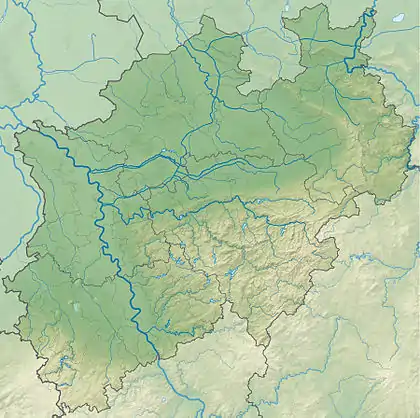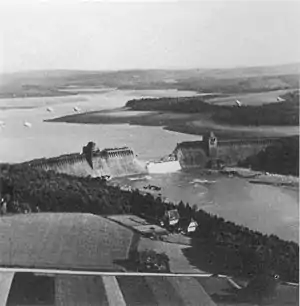Möhne Reservoir
The Möhne Reservoir, or Moehne Reservoir, is an artificial lake in North Rhine-Westphalia, some 45 km east of Dortmund, Germany. The lake is formed by the damming of two rivers, Möhne and Heve, and with its four basins stores as much as 135 million cubic metres of water.
| Möhne Reservoir | |
|---|---|
 The dam of the reservoir | |
 Möhne Reservoir | |
| Coordinates | 51°29′00″N 8°04′18″E |
| Type | artificial lake |
| Primary inflows | Möhne, Heve |
| Primary outflows | Möhne |
| Catchment area | 432 km2 (167 sq mi) |
| Basin countries | Germany |
| Surface area | 1,067 ha (2,640 acres) |
| Water volume | 135×106 m3 (4.8×109 cu ft) |
History
Construction and inauguration
In 1904 calculations about the future demand for water for people and industry in the growing Ruhr-area determined that the existing storage volume of 32.4 million m³ in dams of the Ruhr river system needed tripling. Thus, on 28 November 1904, the general assembly of the Ruhrtalsperreverein decided to construct additional dams. During 1908 to 1913 they built the Möhnetalsperre at a cost of 23.5 million marks.
When opened, the dam was the largest dam in Europe. 140 homesteads with 700 people had to move. It was built to help control floods, regulate water levels on the Ruhr river downstream, and generate hydropower. Today, the lake is also a tourist attraction.


Second World War
The dam (51.489307°N 8.058772°E) was breached by RAF Lancaster Bombers ("The Dambusters") during Operation Chastise on the night of 16–17 May 1943, together with the Edersee dam in northern Hesse. Bouncing bombs had been constructed which were able to skip over the protective nets that hung in the water. A huge hole of 77 m by 22 m was blown into the dam. The resulting huge floodwave killed at least 1,579 people,[1] 1,026 of them foreign forced labourers held in camps downriver. The small city of Neheim-Hüsten was particularly hard-hit with over 800 victims, among them at least 526 victims in a camp for Russian women held for forced labour.
Results of the bombing

Though the Organisation Todt quickly repaired the dams through the labor of 7,000 men taken from the construction of the Atlantic Wall, the impact of the raid on German industry in the Ruhr valley and on the civil population was significant. According to Albert Speer, "the power plant at the foot of the shattered dam looked as if it had been erased, along with its heavy turbines." "Industry was brought to a standstill", due to the "electrical installations being soaked and muddied."[2]
Three other reservoirs were still intact, though the largest, the Sorpe Dam, had a hole above the water line. Another destroyed dam, the Edersee Dam, "had nothing to do with the supply of water to the Ruhr." The Mohne Dam was repaired by 23 September 1943, in time to collect water for needs the following summer, when the British failed to follow up with additional raids to hamper reconstruction.[2]
Further reading
- Helmuth Euler: "Als Deutschlands Dämme brachen. Die Wahrheit über die Bombardierung der Möhne-Eder-Sorpe-Staudämme 1943“. Motorbuch-Verlag, Stuttgart 1975, ISBN 3-87943-367-4.
- Helmuth Euler: "Wasserkrieg – 17. Mai 1943. Rollbomben gegen die Möhne-Eder-Sorpe-Staudämme“. Eigenverlag, Werl 1992, ISBN 3-89053-045-1.
- Wilfried Stichmann, Ursula Stichmann-Marny: Der Möhnesee. Ein Wasservogel-Paradies im Wandel der Zeit. Heimatverein Möhnesee, 2008.
- Heinrich Zimmer: Die Möhnetalsperre. Mit sieben Illustrationen nach photographischen Original-Aufnahmen. In: Reclams Universum: Moderne illustrierte Wochenschrift 27.1 (1911), S. 367–370.
References
- Article of Landschaftsverband Westfalen-Lippe (in German)
- Speer, Albert (1995). Inside the Third Reich. London: Weidenfeld & Nicolson. pp. 384–385. ISBN 9781842127353.
| Wikimedia Commons has media related to Möhne Reservoir dam. |